Subscribe to our ▶️ YouTube channel 🔴 for the latest videos, updates, and tips.
24 Hour Clock
In a 24 hour clock, time runs from midnight to midnight. In this system a.m. or p.m. is not used and instead of using only 12 numbers, we use numbers from 0 to 24 to represent the 24 hours of a day. A 24 hour clock is used in bus and railway timetables, airline schedules, etc.
We know the various units of time and their relationships. Now, we will learn to read a railway time table and a calendar.
Relation between various units of time:
60 seconds = 1 minute
60 minutes = 1 hour
24 hours = 1 day
7 days = 1 week
30 days or 31 days = 1 month
52 weeks + 1 day = 1 year = 365 days
52 weeks + 2 days = 1 leap year = 366 days
10 years = 1 decade
100 years = 1 century
A year is divided into 12 months.
|
Month January February March April May June July August September October November December |
No. of days 31 28 31 30 31 30 31 31 30 31 30 31 |
Note: In a leap year February has 29 days.
|
Position of Hour Hand |
Position of Minute Hand |
Position of Time | |
|
Between 2 and 3 |
At mark 38 |
2:38 (2 Hours 38 Minutes) | |
|
Between 2 and 3 |
At mark 52 |
2:52 (2 Hours 52 Minutes) | |
|
Between 2 and 3 |
At mark 23 |
2:23 (2 Hours 23 Minutes) |
The 24-hour Clock Time:
In our daily life we use a 12-hour clock. But some departments like Railways, Airlines and Armed forces use 24-hour clock. Digital watches also show time in 24-hour clock time.
Look at these clock.
We can see both the clocks are showing the same time But the right hand digital clock 22:30 tells us that it is 10:30 in the night because it expresses 24-hour clock time. 24-hour clock generally used at airports and railway stations to show flight or train timings. It clarifies the confusion of whether it is day or night.
In a 24-hour clock, each new day begins at mid-night. In an analogue clock (12-hour clock), the same time is shown twice a day and we use a.m. or p.m. to tell what part of the day it is.
12-hour clock time 24
hour clock time
12-midnight 2400 hours or 0000 hours
1:00 a.m. 0100 hours
1:30 a.m. 0130 hours
2:00 a.m. 0200 hours
3:00 a.m. 0300 hours
4:00 a.m. 0400 hours
4:50 a.m. 0450 hours
5:00 a.m. 0500 hours
6:00 a.m. 0600 hours
7:00 a.m. 0700 hours
8:00 a.m. 0800 hours
9:00 a.m. 0900 hours
10:00 a.m. 1000 hours
11:00 a.m. 1100 hours
11:10 a.m. 1110 hours
12:00 noon 1200 hours
12:30 p.m. 1230 hours
1:00 p.m. 1300 hours
2:00 p.m. 1400 hours
3:00 p.m. 1500 hours
4:00 p.m. 1600 hours
5:00 p.m. 1700 hours
6:00 p.m. 1800 hours
7:00 p.m. 1900 hours
8:00 p.m. 2000 hours
9:00 p.m. 2100 hours
10:00 p.m. 2200 hours
11:00 p.m. 2300 hours
11:30 p.m. 2330 hours
12:00 midnight 2400 hours
It is clear from the above table that from midnight to 12:00 noon, time remains same on both 12 hour clock and 24 hour clock.
To obtain time on a 24 hour clock, we add 12 to the time on a 12 hour clock in the afternoon.
In the 24-hour clock, the time from midnight to midnight is 1 day (24 hours)
Zero hours or 24 hours = midnight
12 hours = midday = noon 12 hours = 1200 hours
2 p.m. = 1400 hours and so on 1 p.m. = 1300 hours
Rules for Converting 24 Hour to 12-Hour or Standard Time
1. The numeral formed by the two digits from the right denotes the number of minutes.
2. If the numeral formed by the first two digits from the left is less than 12, it denotes the number of hours before noon and so a.m. is to be used with it.
i.e., Use a.m. if the number of hours is less than 12.
For example:
(i) 0845 hours 08:45 a.m.
(ii) 0500 hours 05:00 a.m., or, 5 a.m.
(iii) 1145 hours 11 hrs. 45 min. a.m. or, 11:45 a.m.
(iv) 1020 hours 10:20 a.m.
3. If the numeral formed by the first two digits from the left is greater than 12, the difference between the number and 12 gives the number of hours after noon and so p.m. is to be used with it.
i.e., Use p.m. if the number of hours is more than 12.
For example:
(i) 1345 hours 01:45 p.m. (13 – 12 = 1)
(ii) 2050 hours 08:50 p.m. (20 – 12 = 8)
(iii) 1300 hours 1:00 p.m. (13 - 12 = 1)
(iv) 1845 hours 6.45 p.m. (18 - 12 = 6)
● If the number of hours is 12 and minutes is more than 00, then it is past noon.
For example:
(i) 1220 hours 12:20 p.m.
(ii) 1234 hours 12:34 p.m.
We normally use 12-hour clock system. The hour hand of the clock goes round the dial twice a day (24 hours). Some departments like railways, Airlines, etc use 24-hour clock system because they do not use a.m. and p.m. times.
In a 24-hour clock system, we express time in four digits. The first two digits represent hours and the last two digits represent the minutes.
On the dial there are two
concentric circles. The inner circle has 1 to 12 numbers while the outer
circle has 13 to 24 numbers.
In a 24-hour clock system, we start counting the time from midnight. Let us understand 24-hour system by considering some examples.
(i) 12 midnight is denoted by 24 00 hours or 00 00 hour.
(ii) 12 noon is denoted by 12 00 hours.
(iii) 6 in the morning is denoted by 06 00 hours.
(iv) 10:25 in the evening is denoted by 22 25 hours.
(10:25 + 12:00)
(v) 7:15 in the evening is denoted by 19 15 hours.
(7:15 + 12:00)
From the above examples, we can conclude that between 12 midnight and 12 noon the 24-hour clock time is same.
For example, 10 40 hours = 10:40 a.m., 08 20 hours = 8:20 a.m., 11 30 hours = 11:30 a.m.
But between 12 noon and 12 midnight to convert the 24-hour clock time into 12-hour clock time, we subtract 12 from the 24-hour time.
For example, 19:30 hours = 19:30 – 12:00 = 7:30 p.m.
Similarly, to convert the 12-hour clock time into 24-hour clock time between 12 noon and 12 midnight, we add 12.
For example, 11:30 p.m. = 11:30 + 12:00 = 23:30 hours.
Therefore, the time which is shown by the inner circle is the time before noon and that shown by the outer circle is the time after noon.
These are some more examples:
After midnight 00:10 a.m. is shown as 00:10
02:45 a.m. is shown as 02:45
10:48 a.m. is shown as 10:48
02:45 p.m. is shown as 14:45
10:48 p.m. is shown as 22:48
Clock General Time 24 hour clock
|
00:00 midnight (Just after midnight) or, 12:00 midnight 06:00 a.m.(6 hours zero minutes in the morning) 12:00 noon |
00:00 (Just after midnight) or, 24:00 hours 06:00 12:00 |
We know how to use a.m. and p.m. to represent the time of the day in 12-hour clock. We know that a.m. is used to express time between 12 o’clock mid night to 12 o’clock noon and p.m. is used to express time between 12 o’clock noon to 12 o’clock midnight.
In 24-hour clock time, we express time in four digits. The first two digits from left represt hours and the last two digits represent the minutes.
So, to express time for a.m., we just write the time without separating hours and minutes.
For example; 7:45 am is written as 0745 hours.
5 a.m. on a 24 hour clock = 0500 hours.
To express time for p.m. we add 12 to the hours and then write hours and minutes without separating them.
For example; 6:30 p.m. is written as (6 + 12), 1830 hours.
3 p.m. = 3 + 12 = 1500 hours
Note: We add 12 only for time in the afternoon.
24-Hour Clock Time Format:
The hour hand of the clock goes round the clock twice a day that means 24 hours. 24-hour clock time does not have a.m. or p.m. In 24-hour clock system, we express time in four digits. The first two digits represent hours and the last two digits represent the minutes. There are no dots to separate hours and minutes. The time starts at 0000 hours or 2400 hours which is 12 midnight.
24-Hour Clock Time Chart
Click here to download the 24-Hour Clock Time Chart.
In a 24-hour clock system, we start counting the time from midnight. Let us understand 24-hour system by considering some examples.
1. Converting 12-Hour Clock to 24-Hour Clock Time Format:
12-Hour Time to 24-Hour Time Conversion Table
|
12-Hour Clock Time |
24-Hour Clock Time |
|
12 midnight |
0000 hours or 2400 hours |
|
1 a.m. |
0100 hours |
|
2 a.m. |
0200 hours |
|
3 a.m. |
0300 hours |
|
4 a.m. |
0400 hours |
|
5 a.m. |
0500 hours |
|
6 a.m. |
0600 hours |
|
7 a.m. |
0700 hours |
|
8 a.m. |
0800 hours |
|
9 a.m. |
0900 hours |
|
10 a.m. |
1000 hours |
|
11 a.m. |
1100 hours |
|
12 noon |
1200 hours |
|
1 p.m. |
1300 hours |
|
2 p.m. |
1400 hours |
|
3 p.m. |
1500 hours |
|
4 p.m. |
1600 hours |
|
5 p.m. |
1700 hours |
|
6 p.m. |
1800 hours |
|
7 p.m. |
1900 hours |
|
8 p.m. |
2000 hours |
|
9 p.m. |
2100 hours |
|
10 p.m. |
2200 hours |
|
11 p.m. |
2300 hours |
I. For the first hour of the day (12 Midnight to 12:59 a.m.), subtract 12 hours
For example:
(i) 12 Midnight = 0000 hours
(ii) 12:05 a.m. = 0005 hours
(iii) 12:40 a.m. = 0040 hours
II. From 1:00 a.m. to 12:59 p.m., no change.
For example:
(i) 6:40 a.m. = 0640 hours
(ii) 12:30 p.m. = 1230 hours
(iii) 10:45 a.m. = 1045 hours
III. From 1:00 p.m. to 11:59 p.m., add 12 hours
(i) 3:45 p.m. = 1545 hours (3:45 + 12)
(ii) 6:20 p.m. = 1820 hours (6:20 + 12)
(iii) 08:55 p.m. = 2055 hours (8:55 + 12)
2. Converting 24-Hour Clock to a.m. or p.m.
I. For the first hour of the day (0000
to 0059), add 12 hours to make it a.m.
For example:
(i) 0001 hours = 12:01 a.m.
(ii) 0048 hours = 12:48 a.m.
II. From 0100 hours to 1159 hours, just add a.m. after the hours.
For example:
(i) 0225 hours = 2:25 a.m.
(ii) 1150 hours = 11:50 a.m.
III. From 1200 hours to 12 hours 59, just add p.m. after the hours.
For example:
(i) 1235 hours = 12:35 p.m.
(ii) 1205 hours = 12:05 p.m.
IV. From 1300 hours to 23 hours 59, subtract 12 hours to make it p.m.
For example:
(i) 1355 hours = 1:55 p.m.
(ii) 1725 hours = 5:25 p.m.
Worksheet on 24 Hour Clock Time Format:
I. Convert the time given in a.m. and p.m. form into the
24-hour form. One is shown as an example.
(i) 1 : 24 p.m.
1 : 24 p.m. = 1 : 24 + 12 : 00
= 13 : 24
1 : 24 p.m. = 1324 hours
(ii) 7 : 16 a.m.
(iii) 4 : 55 a.m.
(iv) 6 : 54 p.m.
(v) 9 : 33 p.m.
(vi) 11 : 42 p.m.
Answers:
I. (ii) 0716 hours
(iii) 0455 hours
(iv) 1854 hours
(v) 2133 hours
(vi) 2342 hours
II. Convert the time given in 24- hour form into a.m./p.m. form. One is shown as an example.
(i) 1341 hours
1341 = 1341 – 1200
= 1 : 41 p.m.
1341 = 1 : 41 p.m.
(ii) 2325 hours
(iii) 1750 hours
(iv) 0853 hours
(v) 0432 hours
(vi) 1539 hours
Answers:
II. (ii) 11 : 25 p.m.
(iii) 05 : 50 p.m.
(iv) 08 : 53 a.m.
(v) 04 : 32 a.m.
(vi) 03 : 39 p.m.
III. Convert the following 12-hour clock time to 24-hour clock time.
(i) 7:15 p.m.
(ii) 6:45 a.m.
(iii) 12:15 p.m.
(iv) 2:50 a.m.
(v) 10:10 p.m.
(vi) 6:30 p.m.
Answer:
III. (i) 1915 hours
(ii) 0645 hours
(iii) 1215 hours
(iv) 0250 hours
(v) 2210 hours
(vi) 1830 hours
IV. Change to 24 hour clock time:
(i) 4:15 a.m.
(ii) 6:30 p.m.
(iii) 12:45 p.m.
(iv) 1:20 a.m.
(v) 9:30 a.m.
(vi) 10:25 p.m.
Answer:
IV. (i) 0415 hours
(ii) 1830 hours
(iii) 1245 hours
(iv) 0120 hours
(v) 0930 hours
(vi) 2225 hours
V. Change the 12-hour clock time to the 24-hour clock time:
(i) 10:40 a.m. __________ hours
(ii) 11:20 p.m. __________ hours
(iii) 2:05 a.m. __________ hours
(iv) 2:45 p.m. __________ hours
(v) 8:00 a.m. __________ hours
(vi) 10:00 a.m. __________ hours
(vii) 12:00 noon __________ hours
(viii) 5:00 p.m. __________ hours
(ix) 7:00 p.m. __________ hours
(x) 10:00 p.m. __________ hours
Answer:
V. (i) 2240 hours
(ii) 2320 hours
(iii) 1405 hours
(iv) 1445 hours
(v) 0800 hours
(vi) 1000 hours
(vii) 1200 hours
(viii) 1700 hours
(ix) 1900 hours
(x) 2200 hours
VI. Convert the following 24-hour clock time to 12-hour clock time.
(i) 0400 hours
(ii) 0700 hours
(iii) 1100 hours
(iv) 1300 hours
(v) 1500 hours
(vi) 1800 hours
(vii) 1345 hours
(viii) 0330 hours
(ix) 2035 hours
(x) 0515 hours
(xi) 1655 hours
(xii) 1945 hours
Answer:
VI. (i) 4:00 a.m.
(ii) 7:00 a.m.
(iii) 11:00 a.m.
(iv) 1:00 p.m.
(v) 3:00 p.m.
(vi) 6:00 p.m.
(vii) 1:45 p.m.
(viii) 3:30 a.m.
(ix) 8:35 p.m.
(x) 5:15 a.m.
(xi) 4:55 p.m.
(xii) 7:45 p.m.
VII. Write the following according to the 12-hour clock:
(i) 1720 hours __________
(ii) 0035 hours __________
(iii) 1420 hours __________
(iv) 0008 hours __________
Answer:
VII. (i) 5:20 p.m.
(ii) 12:35 a.m.
(iii) 2:20 p.m.
(iv) 08:00 a.m.
VIII. Change to 12 hour clock time:
(i) 1700 hours
(ii) 1535 hours
(iii) 0030 hours
(iv) 2000 hours
(v) 2215 hours
(vi) 2300 hours
Answer:
VIII. (i) 5:00 p.m.
(ii) 3:35 p.m.
(iii) 12:30 a.m.
(iv) 8:00 p.m.
(v) 10:15 p.m.
(vi) 11 p.m.
IX. Write the correct 24-hour clock time with each analog clock.
Answers:
IX. (i) 1535 hours
(ii) 0505 hours
(iii) 2015 hours
(iv) 0400 hours
(v) 0150 hours
(vi) 2020 hours
(vii) 2230 hours
(viii) 1955 hours
X. Convert 4 days into hours.
Since, 1 day = 24 hours
So, 4 days = 24 × 4 hours
= 96 hours.
XI. Convert 5 days and 5 hours into hours.
Since, 1 day = 24 hours
So, 5 days = 24 × 5 hours
= 120 hours.
Therefore, 5 days and 5 hours = 120 hours + 5 hours
= 125 hours.
XII. The train, Charminar Express runs between Hyderabad and Chennai. The arrival and departure time of it at different stations are given below.
|
Station |
Time |
|
Hyderabad |
a) __________ d) 1900 |
|
Secunderabad |
a) 1920 d) 1930 |
|
Warangal |
a) 2159 d) 2201 |
|
Khammam |
a) 2346 d) 2348 |
|
Vijayawada |
a) 0145 d) 0155 |
|
Chennai |
a) 0920 d) __________ |
a → Arrival Time
d → Departure Time
Observe the table and answer the following questions in 12-hour clock time.
(i) When does the train arrive at Warangal station?
(ii) At what time does the train leave Vijayawada station?
(iii) When does the train start from Hyderabad station?
(iv) At what time does the train reach Chennai?
Answer:
XII. (i) 9:59 p.m.
(ii) 1:55 a.m.
(iii) 7:00 p.m.
(iv) 9:20 a.m.
XIII. Complete the following table. Use a.m. or p.m. or 24 hours clock time as per the sum.
|
Starting time |
Duration |
Finishing time |
|
6:30 a.m. |
4 hours 20 minutes |
_____________ |
|
1500 hours |
8 hours 15 minutes |
_____________ |
|
_____________ |
3 hours 20 minutes |
2100 hours |
|
_____________ |
4 hours 40 minutes |
12:40 p.m. |
|
1400 hours |
_____________ |
2015 hours |
Answer:
XIII.
|
Starting time |
Duration |
Finishing time |
|
6:30 a.m. |
4 hours 20 minutes |
10:50 a.m. |
|
1500 hours |
8 hours 15 minutes |
2315 hours |
|
1740 hours |
3 hours 20 minutes |
2100 hours |
|
8:00 a.m. |
4 hours 40 minutes |
12:40 p.m. |
|
1400 hours |
6 hours 15 minutes |
2015 hours |
Word Problems on 24 Hour Clock:
1. Nairitee starts travelling at 10 o'clock and reaches her destination at 1400 hours. Write her starting time and reaching time according to the 12 hour clock.
According to the 12 hour clock;
Nairitee's starting time is 10:00 a.m.
And her reaching time is 2:00 p.m.
2. Ron starts driving the car at 1300 hours and reaches his destination at 1600 hours. Write his starting time and reaching time according to the 12 hour clock.
According to the 12 hour clock;
Ron's starting time is 1:00 p.m.
And his reaching time is 4:00 p.m.
3. Mary and Ana starts the journey at 9:00 am. and they reached destination at 5:00 p.m. Write their starting time and reaching time according to the 24 hour clock.
According to the 24 hour clock; their starting time is 0900 hours and their reaching time is 1700 hours.
Related Concepts
● To Measure the Length of a Line-segment
● Examples on Unit of Mass or Weight
● Units for The Measurement of Capacity
● Examples on Measurement of Capacity
● Antemeridian (a.m.) or Postmeridian (p.m.)
● Calendar
● Reading and Interpreting a Calendar
4th Grade Math Activities
From 24 Hour Clock to HOME PAGE
Didn't find what you were looking for? Or want to know more information about Math Only Math. Use this Google Search to find what you need.
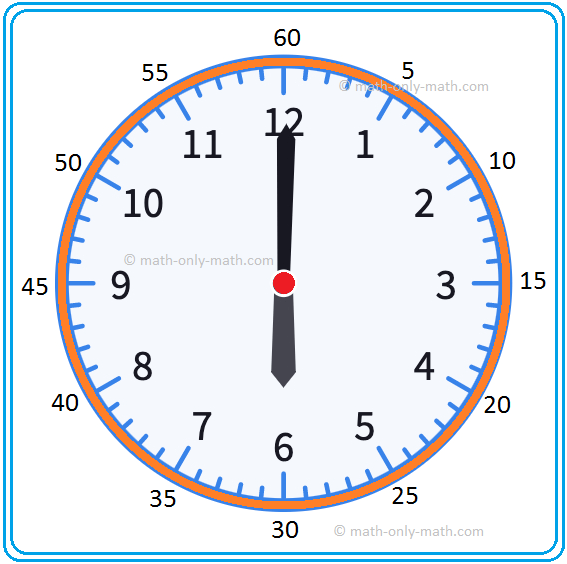
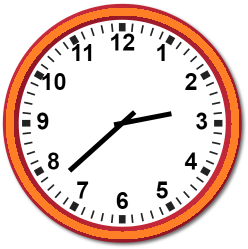
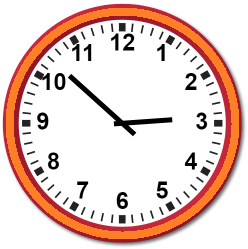
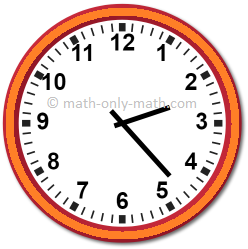

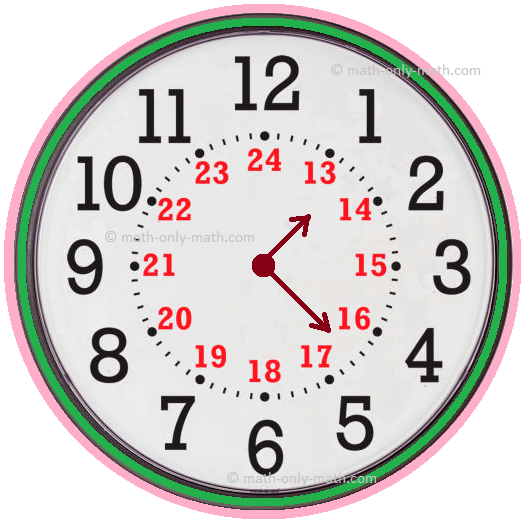
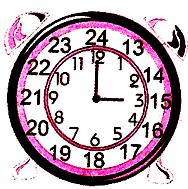
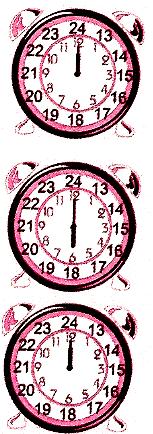
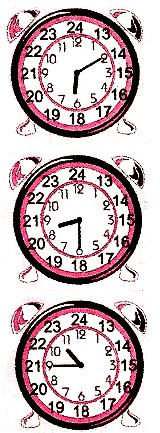
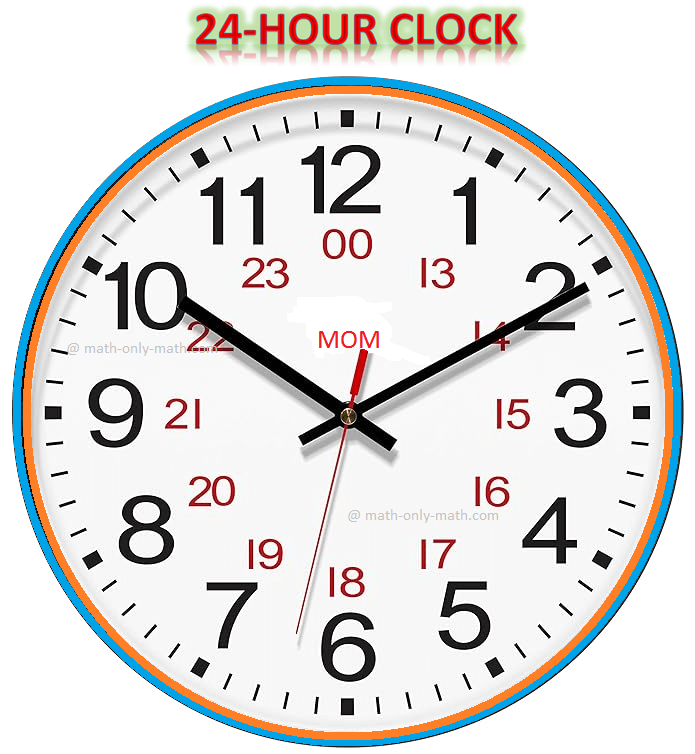
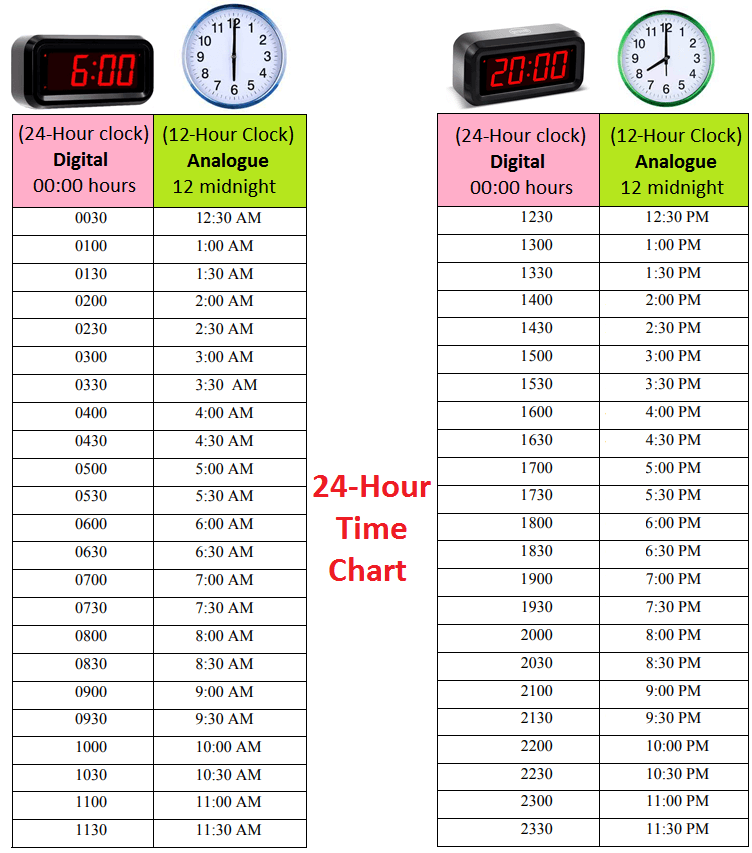
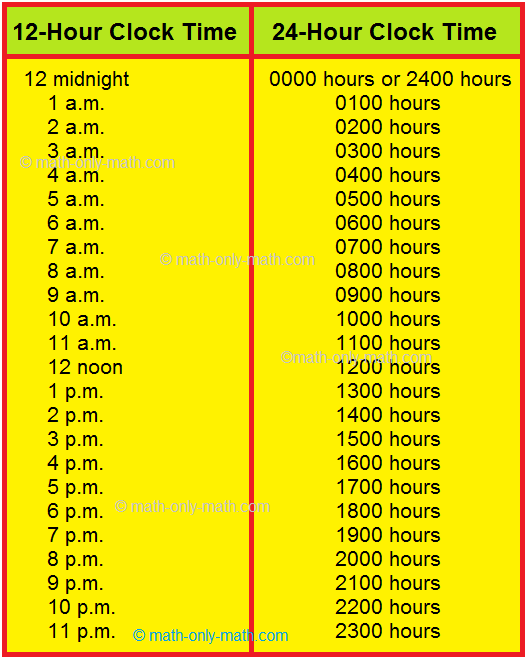
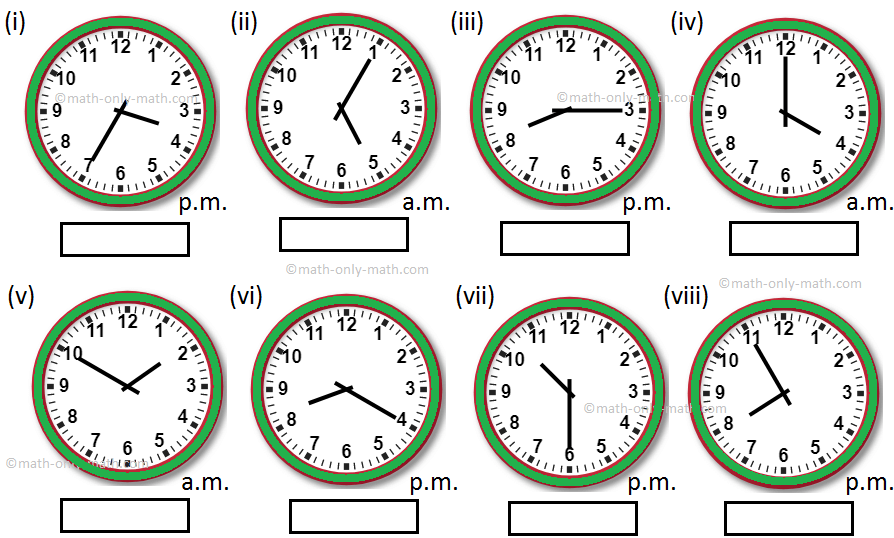


New! Comments
Have your say about what you just read! Leave me a comment in the box below. Ask a Question or Answer a Question.